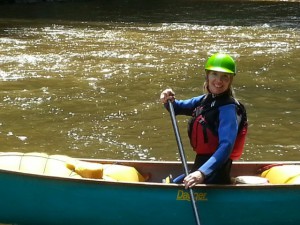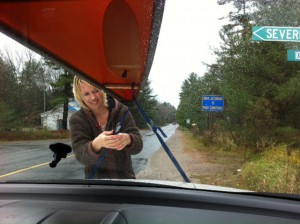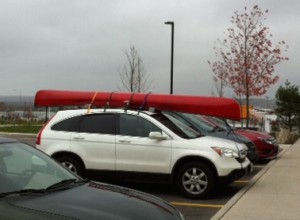Falling Down the Thames Blog 21, 06th August 2014
Canoes Don’t Like Highways
Once Glen and I had shaken hands on Falling Down the Thames as our next adventure, I decided that I would be smart to purchase a solo canoe to practice paddling. This decision was less due to me actually needing a boat (I already have a perfectly functional sea kayak and a tandem canoe), but more due to the fact that I love outdoor gear and this seemed like a great excuse to add to my existing fleet of seaworthy vessels.
I chose a canoe that would be lightweight enough for me to lift on and off the roof of my car by myself. Its other criteria was that it would also be roomy enough to allow my dog, Fixie, to join me, in case I lost my mind one day and saw that as a good idea.
My friend, Rob, and I drove 2.5 hours north of Toronto to Swift Canoes and Kayak. Their boats are handcrafted in Canada, so I could further justify my purchase by helping the domestic economy. I picked a perfect day to buy a canoe in Canada – an exceptionally windy, rainy, cold day in mid-November.
The folks at Swift Canoes were terrific at helping me with my selection. They suggested the Keewaydin 15, weighing a mere 30 lbs. That sounded great. And it was on clearance.
It had been a while since I had transported a canoe on my car’s roof. It had been even longer since I had transported a canoe on my car’s roof in inclement weather. The art of securing a canoe to a vehicle involves a few essentials:
1) Being able to safely load it onto the roof of your car. A canoe is much more difficult to carry when you need to lift it to a height above your head.
2) Having a padded yet non-slip surface between your roof or your roof rack and the gunnels of your canoe. I did not have a roof rack so we opted for specifically-designed foam blocks.
3) Strapping the body of the canoe to your car’s roof or the roof rack. Again, in my case – without a roof rack – we ran the straps over the canoe transversely and under the roof of the car. As the straps are tightened, it is important to put enough tension on the strap without deforming the canoe (or your roof). We started with two body straps, which is standard.
4) Securing the bow and stern to the front and rear of your vehicle, respectively. These straps are intended only to control the boat in case it slides around under the body straps (which it should not do if you have enough tension on the body straps and have the boat on a nonslip surface). The bow and stern straps are not intended to be primary means of securing the boat. We used straps with hooks and secured them to hooks under my car’s body.
And off we drove. The wind had significantly picked up since we arrived, and we were now enduring 80 km/hr cross winds on the highway. My lightweight boat now posed a huge problem. A 30lb canoe with a height of 18 inches and length of 15 feet offers a tremendous surface area for the wind to push against, with little resistance to being tossed around.
I knew we were in trouble when people in passing cars started frantically waving and pointing to the top of my car. Time to pull over. Sure enough, the boat was being tossed around with no hope of the two body straps of holding it in place. We carefully crawled along the highway, stopping at each exit in the hopes of finding something to better secure the boat. I was about ready to settle for duct tape, when we came across a hardware store which carried tie down straps. We added two more body straps and another one on the bow for good measure. And off we went.
The return trip took 4 hours. I probably could have paddled it home faster. But I learned my lesson…there is a reason people don’t drive around with boats on their cars in the winter.
- Krista



